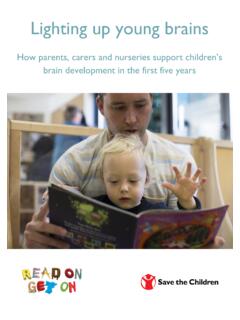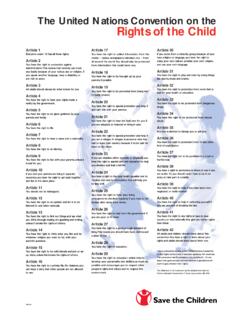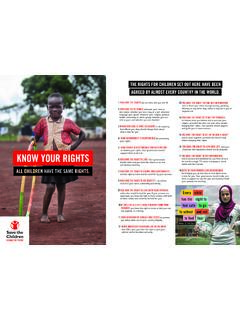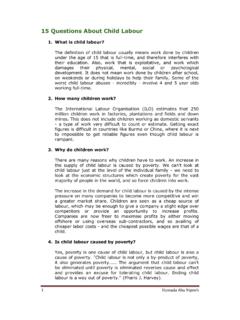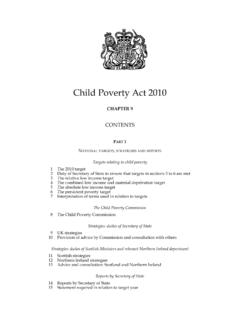Transcription of TACKLING CHILD POVERTY AND DESTITUTION
1 TACKLING CHILD POVERTY AND DESTITUTION : NEXT STEPS FOR THE SCOTTISH CHILD PAYMENT AND THE SCOTTISH WELFARE FUND By Rachel Statham, Casey Smith and Henry Parkes02 ContentsACKNOWLEDGEMENTSThis report was authored by Rachel Statham, Casey Smith and Henry Parkes at IPPR Scotland for the Trussell Trust and Save the authors would like to thank Cara Hilton, Emily Spoor, Polly Jones and Thomas Weekes at the Trussell Trust, and Fiona King and Claire Telfer at Save the Children for their input into this work. At IPPR Scotland, thanks to Russell Gunson and Philip to our research participants for sharing their time and insights, and to One Parent Families Scotland and the Edinburgh Food Project for their role as recruitment partners.
2 Finally, thanks to officials at COSLA and local authority staff who shared their perspectives as part of this work, and to colleagues across Scotland s anti- POVERTY sector and wider civil society organisations who engaged in a policy workshop that shaped this project. 03 AcknowledgementsCONTENTSE xecutive Summary ..04 Future directions for the Scottish CHILD Payment ..04 Future directions for the Scottish Welfare Fund ..06 Introduction ..09 Chapter 1: Scottish CHILD Payment .. Background to the Scottish CHILD Payment .. Future directions for the Scottish CHILD Payment .. Conclusions .. Recommendations for the Scottish CHILD Payment ..26 Chapter 2: Scottish Welfare Fund.
3 Background to the Scottish Welfare Fund .. Future directions for the Scottish Welfare Fund .. Conclusions .. Recommendations for the Scottish Welfare Fund ..43 Chapter 3: Conclusion ..45 References ..4604 Executive SummaryEXECUTIVE SUMMARY Scotland stands at a crossroads on its path to securing a fairer country, free from POVERTY and DESTITUTION . Even before the Covid-19 pandemic, rates of relative CHILD POVERTY and deep poverty1 across Scotland were rising, and the amount of food bank parcels distributed to households was at an all-time high (Hetherington 2020; Birt et al 2021; The Trussell Trust 2021). Now, as the pandemic subsides and emergency support is withdrawn, households face a mounting cost of living crisis, driven by rising food and fuel costs.
4 While these pressures will strain households budgets across Scotland, people already living on low incomes are likely to be the hardest hit by rising prices (ONS 2022a). Without action, these factors stand to form a perfect storm that could sweep more people into POVERTY or pull them deeper underwater. Scotland has set ambitious and legally binding CHILD POVERTY targets for 2030/31, with interim targets in 2023/24. Through its current TACKLING CHILD POVERTY Delivery Plan, the Scottish Government has introduced new measures designed to bring down rates of CHILD POVERTY , most notably through the introduction of the Scottish CHILD Payment. As a new payment which will get money directly to families on low incomes, it has the potential to reduce POVERTY and protect against DESTITUTION over the long term.
5 But in the face of strengthening headwinds, it will have to go further over the course of this parliament to deliver on its full potential. Alongside long-term, preventative investment like the Scottish CHILD Payment, emergency support will also need to be strengthened to protect people across Scotland from DESTITUTION in the months ahead. For households already struggling to make ends meet, the unexpected cost of rapidly rising bills risks setting in motion a domino effect with potentially catastrophic consequences. To protect against the threat of DESTITUTION , emergency support such as that offered by the Scottish Welfare Fund must provide a stronger safety net.
6 As we look ahead to the Scottish Government s second TACKLING CHILD POVERTY Delivery Plan, due to be published in March, this report explores how these two forms of support can go further and faster to protect people across Scotland from the coming DIRECTIONS FOR THE SCOTTISH CHILD PAYMENT The Scottish CHILD Payment represents a major step in TACKLING CHILD POVERTY and setting a path towards meeting the Scottish Government s statutory targets. Through our research, we find that the payment has been welcomed by the families who receive it who value its reliability, certainty, and simplicity but that does not mean there is no room for improvement. We find that the payment could better respond to individual circumstances by increasing in flexibility, especially with regards to frequency of payments, and families could benefit from simpler and more automated application processes across the range of support available from local government and Social Security Scotland.
7 We also consider the early impacts of the payment and find that where its initial roll out to children aged under 6 coincided with the withdrawal of the Universal Credit uplift, or with children losing eligibility from their 6th birthday, its impact has been muted. It is clear the payment will need to go further to provide families with a springboard away from POVERTY , not just a lifeline. We also find that the payment alone cannot do all the heavy lifting required at least at its current level, or how it is targeted to meet CHILD POVERTY targets. Current IPPR Scotland estimates suggest it will lift 1 We define deep POVERTY as living in a household with an income below 50 per cent of the median household income, after adjustment for household composition.
8 Both measures refer to income after housing Summary30,000 children out of POVERTY once fully rolled out by the end of 2022 falling three percentage points, or 30,000 children, short of the Scottish Government s interim target. In response, we consider whether alternative models of delivery could push Scotland closer towards realising its ambitions, and better lift those on the lowest incomes up, through a higher payment, increasing take up, and introducing additional premiums for families most at risk of POVERTY . We find that better targeting could help to bring more children above the POVERTY line and lift more families out of deep POVERTY , protecting them from the risk of DESTITUTION .
9 In response to our findings, we recommend that the Scottish Government should immediately: 1. Design and deliver a public awareness campaign in 2022-23 coinciding with roll out to children aged under 16 aimed at substantially increasing take up of the Scottish CHILD Payment. This should be co-designed by prospective claimants and engage a wide range of support workers and front-line service staff who might play a role in supporting eligible families to Bring together local and national government, along with anti- POVERTY groups, to develop plans to automate access to the Scottish CHILD Payment for families in receipt of Best Start Grants and Best Start Foods, and vice versa.
10 This automation effort should be designed to pave the way to automated payments across all relevant support provided by Social Security Scotland and local Convene COSLA and Social Security Scotland to explore how to ensure the Scottish CHILD Payment can act as a passport to wider support ensuring: a no wrong door approach for families on a low income; that wherever possible links are drawn across public services; and, that sign-posting and proactive help is in place to ensure families can access the Scottish CHILD Payment and other forms of support, including advice on income maximisation and employability the course of this parliament, the Scottish Government should: 4.
